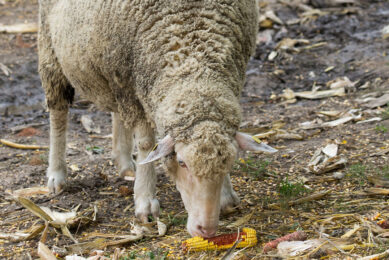New insights for effective mould control

Recent studies indicate that mould inhibitors are more effective when the propionate fraction is activated during the production process. For mould control, it means a more cost effective strategy to maintain the nutritional quality and safety of raw materials and feed.
By Jaco Eissen, Maarten van der Heijden and Hans van Dam
Moulds are micro organisms that produce thousands of tiny particles called spores as part of their reproductive cycle. Actively growing mould colonies are usually visible as colourful ‘woolly’ or ‘slimy’ growths. They can be virtually any colour – red, blue, brown, green, white or black. There are thousands of known species of moulds worldwide. The presence of mould in feeds is a persistent problem. The need to control moulds is that they consume the main ingredients. This results in a deteriorated nutritional quality like a reduced starch and protein content, and a poorer palatability. Moreover, moulds also produce mycotoxins which pose a serious threat to animal and human health – even low levels can result in sub-clinical health problems and reduced productivity. Nelson (1993) already indicated that mould growth is likely the most important microbiological activity with both nutritional and toxicological implications that should be controlled from a commercial animal nutrition point of view.
Drivers in mould formation
There are a couple of drivers determining mould growth in raw materials and animal feeds as described by Nelson (1993) and D’Mello (2004).
- Mould needs the right nutrients for growth, like nitrogen and energy sources. Intact grains physically protect the nitrogen and energy resources of the seed. As long as this covering remains intact, moulds only grow slowly, if at all.
- Moulds need the right temperature and conditions for optimal growth. This is influencing the distribution of mould species around the world. For example, Aspergillus and Penicillium species especially flourish in warmer temperatures, whereas Fusarium moulds prefer cooler temperatures. As a consequence, Aspergillus and Penicillium related problems are more apparent in (semi-)tropical climates and Fusarium incidence is higher in temperate regions.
- Moulds need oxygen for living as they are obligate aerobic organisms. The proliferation and growth can therefore be controlled by providing oxygen-free storage.
- Moulds need free water for their metabolism. Water activity (aw-value) is often used as an indicator of the volume of free water. Aw-values greater than 0.6 indicate an increased risk of mould growth.
An efficient control programme is complex with several factors involved in the growth of moulds. Besides, the quality of mould control measures in previous tiers of the raw material and feed chain cannot always be ensured. This is reflected in scientific reports that state 15% of pig diets and 28% of poultry diets exceed acceptable mould levels (Marković et al., 2005) with 25.4% of corn samples being mould positive (Russel et al., 1991). As a consequence, mould inhibitors are used in commercial practice as a strategy to maintain the nutritional quality and safety and extend the shelf life.
Organic acids as solution
The two main characteristics a mould inhibitor product should offer is an effective broad spectrum killing of vegetative moulds with a long lasting protective effect against germination of existing mould spores and/or recontamination with moulds. Therefore, mould inhibitors are best formulated from combinations of known anti mould agents because individual compounds have different efficacies against various moulds. Besides, the substances used should be stable and not disappear from the feed by natural degradation or evaporation. Use of multiple ingredient inhibitors that work synergistic ensures the broadest spectrum of activity within the feed. In practice, mould inhibitors usually contain various levels and combinations of organic acids with propionic acid being the principle ingredient. Propionic acid is regarded by many as the most cost effective anti mould product for use in animal feed (Frost and Sullivan, 2004).
Organic acids are strong mould inhibitors. However, as they have a low pH they are corrosive by nature to both man and machinery. Buffering of organic acids making ammonium, sodium or potassium salts is an effective way to make anti-mould products non corrosive and by that safer to handle (Figure 1). An additional advantage of buffering organic acid products is that acids become less liable to evaporate, keeping them active in the feed material. This is supporting a long lasting protective effect. As a consequence, most commercial products are buffered by various salts. Ammonium salts have an advantage over the others because of their ability to deliver H+ protons, supporting a more effective anti mould operation. Surfactants may be used to further strengthen the working of organic acids. They reduce the surface tension of water and the interfacial tension between oil and water. Surfactants are added to liquid organic acid blends to reinforce the anti mould effect of organic acids in two ways. They ensure that the anti mould product and water are evenly distributed throughout the feed material so that the entire material receives an anti mould treatment. Moreover, surfactants also improve the water binding capacity of feed materials by lowering the water activity (aw-value). The lower the water activity, the better the conditions for prevention of mould growth.
Activated propionates
Killing moulds requires a somewhat different approach for organic acids than killing bacteria as the acids not only need to pass the cell membrane but also the outer cell wall. Propionic acid is regarded as the most cost effective anti mould product in animal feed with a proven track record (Frost and Sullivan, 2004). Evidently, propionic acid deals in a more effective way than other products with this ‘double barrier’. The exact mode of action remains to be elucidated but the helical structure and lipophylic characteristics of propionic acid seems to play a crucial role. Still, there are articles reporting a certain tolerance to propionic acid and some species may even use propionic acid as a substrate (Brock and Buckel, 2004; Suhr and Nielsen, 2004).
The anti-mould characteristics of propionic acid may be further strengthened by ‘activating’ propionates during the production process. This was the outcome of recent experimental studies at Nutreco R&D. The formation of activated propionates takes place in a neutralisation reaction with ammonium hydroxide combined with a micelles stimulating technology (Figure 2). The result is activated ammonium propionates bound in micelles. These micelles increase the porosity of the cell wall and destabilise the cell membrane of the mould, leading to an increased openness for and influx of organic acids. Inside the mould, organic acids dissociate decreasing the intracellular pH. This will inhibit glycolysis and ultimately kill the mould (Krebs et al., 1983). This activation of moulds may eliminate the previously noted disadvantage of propionic acid.
More effective mould control
The benefits of activated propionates was further studied at the Ingredient Research Centre of Nutreco in the Netherlands. Three types of products were compared in a laboratory study using two in vitro models. The three types of products were:
- Ammonium propionate as reference for industrial standard (Amm. Propionate)
- Three commercially available mould inhibitors based on a high level of propionates (Product 1, 2 and 3).
- Mould inhibitor based on a high level of propionates that were activated during the production process.
All three product types were tested in a mixed mould culture containing the species Aspergillus, Penicillium, Fusarium and Zygomycetes. Two different test methods were developed to mimic, in a lab environment, the commercial storage conditions of feed raw materials and compound feeds. These were a tube MIC test (Minimal Inhibitory Concentration; adapted from Khan et al., 2006 and Kuzucu et al., 2004) and an accelerated shelf life test, also called ‘stress test’. The use of activated propionates improved the anti-mould working a great deal. The results (Table 1 and 2 and Figure 3) of all three commercial products were similar to ammonium propionate, each showing a decent anti-mould function with stronger effects at higher dosages.
The activation of ammonium propionate during the production process resulted in a 50% improvement of MIC values. In line, an improvement in efficacy of 79 to 87% was achieved in the shelf life test compared to ammonium propionate and commercial products. This matches with a strong reduction in needed dosage to arrive at an equal shelf life extension as normal propionates. These results indicate that a propionic acid based mould inhibitor with a production process activating the ammonium propionates is a strong combination. For mould control, this means a more cost effective strategy to maintain the nutritional quality and safety of raw materials and feeds.
Source: FeedMix vol 17 nr 3, 2009












